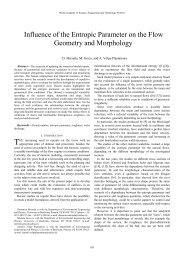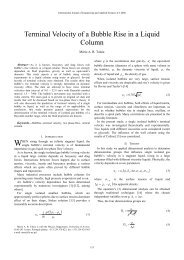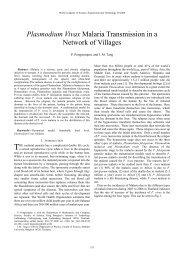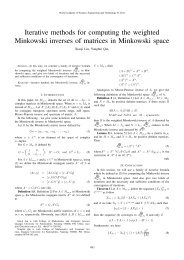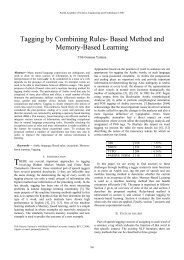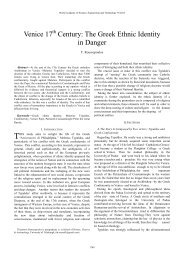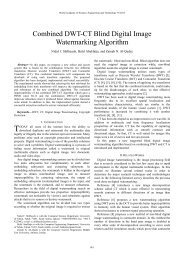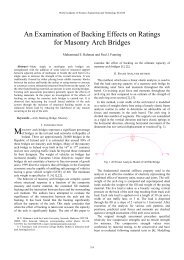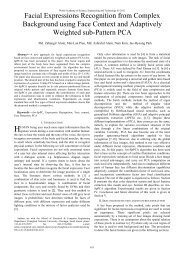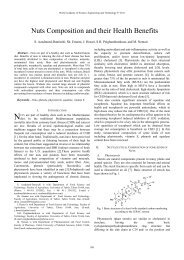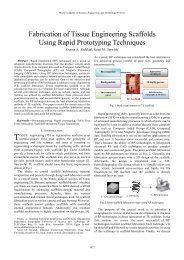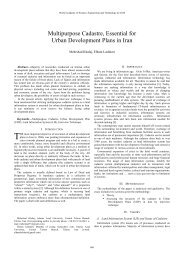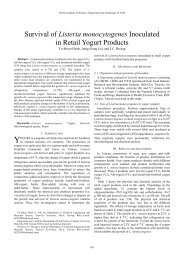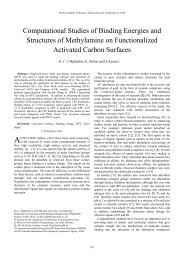Design of Hydraulic Circuit for CNC Lathe Machine Converted from ...
Design of Hydraulic Circuit for CNC Lathe Machine Converted from ...
Design of Hydraulic Circuit for CNC Lathe Machine Converted from ...
Create successful ePaper yourself
Turn your PDF publications into a flip-book with our unique Google optimized e-Paper software.
Abstract—Nowadays, products can be produced by modern<br />
technology, which uses computer s<strong>of</strong>tware, hardware and firm ware<br />
in industries. It is needed to use <strong>CNC</strong> lathe machine to get more<br />
accurate dimensions and irregular shape. So, <strong>CNC</strong> machines are<br />
becoming more and more important in modernized industrialization.<br />
There are many conventional lathe machines in our country,<br />
Myanmar. To build a new modern developed country, it is required<br />
to convert these conventional lathe machines into semi automatic<br />
control lathe machine. Developing and changing into semi automatic<br />
control lathe machine, there are three required portions, namely,<br />
mechanical, electronics and mechatronics. From the mechanical point<br />
<strong>of</strong> view, the design <strong>of</strong> hydraulic circuit is dramatically needed. The<br />
functions <strong>of</strong> hydraulic circuits <strong>for</strong> semi automatic control lathe are<br />
analyzed in this paper. These consist <strong>of</strong> changing the tool, working<br />
the machining processes and locating the tool in turret. In this<br />
research paper, the hydraulic circuit design which can be changed<br />
four kinds <strong>of</strong> tools by using hydraulic motor is made and also<br />
constructed. The hydraulic circuit comprises vane pump, hydraulic<br />
motor, and two directional control valves <strong>for</strong> changing the tool; 4/3-<br />
way valve and 4/2-way valve. The transfer function <strong>of</strong> each<br />
component is derived and the whole system is analyzed in this thesis.<br />
Keywords—Accurate, changing, circuit and vane pump.<br />
A<br />
<strong>Design</strong> <strong>of</strong> <strong>Hydraulic</strong> <strong>Circuit</strong> <strong>for</strong> <strong>CNC</strong> <strong>Lathe</strong><br />
<strong>Machine</strong> <strong>Converted</strong> <strong>from</strong> Conventional <strong>Lathe</strong><br />
<strong>Machine</strong><br />
I. INTRODUCTION<br />
lathe is a machine tool <strong>for</strong> producing cylindrical, conical<br />
and flat surfaces. It can be used <strong>for</strong> drilling and boring<br />
holes which may be cylindrical or conical in shape. The basic<br />
engine lathe, one <strong>of</strong> the most widely used machine tools is very<br />
versatile when used by a skilled machinist. However, it is not<br />
particularly efficient when many identical parts must be<br />
machined as rapidly as possible. Numerical control is based on<br />
the use <strong>of</strong> numerical data <strong>for</strong> directly controlling the position<br />
<strong>of</strong> the operative units <strong>of</strong> a machine tool in machine operation.<br />
Today, a more popular adaptation <strong>of</strong> the basic process <strong>of</strong> NC<br />
is called Computer Numerical Control or <strong>CNC</strong>. Computer<br />
Zin Ei Ei Win is with Mechanical Engineering Department, Mandalay<br />
Technological University (corresponding author to provide phone: 095-09-<br />
513-7242; fax: 095-067-404015; e-mail: zineieiwin@ gmail.com).<br />
Than Naing Win, Jr., is with Mechanical Engineering Department,<br />
Mandalay Technological University (corresponding author to provide phone:<br />
095-09-215-0122; fax: 095-067-404015; e-mail: kaunghtet57@ gmail.com).<br />
Seine Lei Win is with Mechanical Engineering Department, Mandalay<br />
Technological University (corresponding author to provide phone: 095-09-<br />
513-7242; fax: 095-067-404015; e-mail: seinelei1@ gmail.com).<br />
World Academy <strong>of</strong> Science, Engineering and Technology 18 2008<br />
Zin Ei Ei Win, Than Naing Win, Jr., and Seine Lei Winn<br />
401<br />
numerical control is the process <strong>of</strong> manufacturing machined<br />
parts using a computerized controller to command motors<br />
which drive each machine axis.<br />
In no field <strong>of</strong> engineering development has progress been so<br />
rapid in that <strong>of</strong> hydraulic operation. There<strong>for</strong>e, hydraulic<br />
devices and control systems have become more and more<br />
important due to automation and mechanization. Similarly, in<br />
changing the tool in <strong>CNC</strong> lathe machine, hydraulic is used to<br />
control the manufacturing processing <strong>of</strong> this machine.<br />
In controlling processing, there are two types <strong>of</strong> control<br />
system on NC/<strong>CNC</strong> machines viz. open loop and closed loop.<br />
The overall accuracy <strong>of</strong> the machine is determined by the type<br />
<strong>of</strong> control loop used. The opened loop control system does not<br />
provide positioning feedback to the control unit. The<br />
movement pulses are sent out by the control unit and are<br />
received by a special type <strong>of</strong> servomotor command. Since this<br />
control system only counts pulses and cannot identify<br />
discrepancies in positioning, the control has no way <strong>of</strong><br />
knowing whether the tool has reached the proper location or<br />
not. The machine will continue this inaccuracy until somebody<br />
finds the error. The opened loop control can be used in<br />
application in which there is no change in load conditions,<br />
such as the NC drilling machine. The advantage <strong>of</strong> the open<br />
loop control system is that it is less expensive, since it does<br />
require the additional hardware and electronics needed <strong>for</strong><br />
positioning feedback. The disadvantage is the difficulty <strong>of</strong><br />
detecting a positioning error. In the closed loop control<br />
system, the electronic movement pulses are sent <strong>from</strong> the<br />
control to the servomotor, enabling the motor with each pulse.<br />
The pulses are detected and counted by a feedback device<br />
called a transducer. With each step <strong>of</strong> movement, a transducer<br />
sends a signal back to the control, which compares the current<br />
position <strong>of</strong> the driven axis with the programmed position.<br />
When the number <strong>of</strong> pulses sent and received match, the<br />
control starts sending out pulses <strong>for</strong> the next movement.<br />
Closed loop systems are very accurate. Most have an<br />
automatic compensation <strong>for</strong> error, since the feedback device<br />
indicates the error and the control makes the necessary<br />
adjustments to bring the slide back to its position. They use<br />
AC, DC or hydraulic servomotors. These various motors are<br />
mounted by hydraulic circuits or system. The term ‘hydraulic<br />
circuit’ is a group <strong>of</strong> components such as pumps, actuators,<br />
control valves, accumulators, restrictors, and pipelines.
II. AIM AND OBJECTIVE<br />
The main ambition <strong>of</strong> this research is to design hydraulic<br />
circuit <strong>for</strong> <strong>CNC</strong> lathe machine which is more useful than<br />
conventional lathe machine. This circuit makes the machine<br />
faster, more safety and reliable. The objective <strong>of</strong> this thesis is<br />
to analyze the working principle <strong>of</strong> components in the<br />
hydraulic circuit and to design the hydraulic control system in<br />
<strong>CNC</strong> lathe machine.<br />
III. SCOPE OF THESIS<br />
To design the hydraulic circuit <strong>for</strong> <strong>CNC</strong> lathe machine, the<br />
relative components and the working principle <strong>of</strong> components<br />
in this machine should firstly be analyzed.<br />
After studying the technologies <strong>of</strong> components, the basic<br />
concept <strong>of</strong> hydraulic circuit is analyzed <strong>for</strong> certain and the<br />
whole hydraulic circuit is designed. And then the transfer<br />
functions <strong>of</strong> hydraulic circuit are derived <strong>for</strong> providing<br />
MATLAB program.<br />
IV. ESSSENTIAL FACTORS IN DESIGNING HYDRAULIC CIRCUIT<br />
There are three important consideration when designing<br />
hydraulic circuit and analyzing. They are as follows:<br />
(i) Safety <strong>of</strong> desired function<br />
(ii) Per<strong>for</strong>mance <strong>of</strong> desired function<br />
(iii) Efficiency <strong>of</strong> operation<br />
V. DESIGN CONSIDERATION OF HYDRAULIC CIRCUIT<br />
At present day, it is required to convert conventional lathe<br />
machines that are most widely used in many industrial zones in<br />
Myanmar, into semi automatic control lathe machines.<br />
Developing and changing into semi automatic control lathe<br />
machine, there are three necessary portions, namely,<br />
mechanical, mechatronics, and electronics. From the<br />
mechanical point <strong>of</strong> view, it is absolutely needed to design the<br />
hydraulic circuit <strong>for</strong> semi automatic control lathe machines.<br />
Fig. 1 Conventional <strong>Lathe</strong> <strong>Machine</strong><br />
World Academy <strong>of</strong> Science, Engineering and Technology 18 2008<br />
402<br />
Basically, there are two types <strong>of</strong> pump; dynamic and<br />
positive displacement pumps. We choose the type <strong>of</strong> positive<br />
<strong>for</strong> it can change in the small internal leakage that makes the<br />
output flow constant. And, positive displace pumps are divided<br />
into three types, namely, gear, vane and piston pumps.<br />
However, the gear pump is one type <strong>of</strong> the fixed<br />
displacement pumps. Moreover, although the piston pump can<br />
be designed both fixed and variable displacement design, it is<br />
more accurate <strong>for</strong> getting the reversible flow through the<br />
pump.<br />
There<strong>for</strong>e, the vane type pump is chosen. On the other hand,<br />
it doesn’t need reversible flow and only needs variable type <strong>for</strong><br />
<strong>CNC</strong> lathe machine converted <strong>from</strong> conventional lathe.<br />
However, there are two types in vane pump; unbalance and<br />
balance. We choose the unbalance type because a balance<br />
vane pump can’t be designed as a variable displacement unit.<br />
After all, an unbalance vane pump is chosen <strong>for</strong> hydraulic<br />
circuit in <strong>CNC</strong> lathe machine.<br />
VI. EXPERIMENTAL PROCEDURE<br />
Fig. 2 <strong>Hydraulic</strong> <strong>Circuit</strong> in <strong>CNC</strong> <strong>Lathe</strong> <strong>Machine</strong><br />
The diagram <strong>of</strong> hydraulic circuit in <strong>CNC</strong> lathe machine at<br />
Pyin Oo Lwin (G.T.I) in Myanmar is shown in Fig. 2. In this<br />
operation, vane pump is required to supply the pressurized<br />
fluid which is controlled to drive hydraulic motor or hydraulic<br />
cam type lathe turret by a directional control valve; 4/3 way.<br />
The flow being controlled by this valve then passes to<br />
hydraulic motor connected to the load.<br />
The cylinder piston controls the position <strong>of</strong> tool changer via<br />
a directional control valve; 4/2 way, in order to be clamped or<br />
unclamped. In the condition <strong>of</strong> machining <strong>of</strong> screwing the<br />
work piece, the tool changer tool must be in the clamp
position. On the other hand, the tool changer must be in the<br />
unclamp position when changing the tools as desired.<br />
A. <strong>Design</strong> Calculation <strong>of</strong> Vane Pump<br />
Fig. 3 Measurements <strong>of</strong> Vane Pump<br />
Basing on the following equation,<br />
TT = (VD _pp) / 2π (1)<br />
We have the outlet pressure <strong>of</strong> pump; 2158.14 kPa.<br />
ηv = QA/ QT (2)<br />
Volumetric efficiency; ηv is 96.3 %.<br />
B. Determination <strong>of</strong> Pipe Flow<br />
Fig. 4 <strong>Hydraulic</strong> <strong>Circuit</strong> Diagram with Pipe Measurements<br />
For deciding laminar or turbulent, we should consider about<br />
Reynolds Number which is dimensionless. For both pipes <strong>of</strong><br />
L1 and L2 in Fig. 4, the flows are laminar.<br />
World Academy <strong>of</strong> Science, Engineering and Technology 18 2008<br />
403<br />
C. Calculation <strong>for</strong> Cylinder Piston<br />
Basing on the head losses <strong>of</strong> valve and pipes between pump<br />
and cylinder piston, we have the <strong>for</strong>ce <strong>of</strong> extension and<br />
retraction <strong>of</strong> cylinder; 11.52 kN and 17.54 kN respectively.<br />
And the power <strong>of</strong> cylinder is 0.7 kW.<br />
D. Calculation <strong>for</strong> Motor<br />
This motor is a type <strong>of</strong> piston motor which is produced <strong>from</strong><br />
Lio Shin Company. Its can operate at 80 rpm and its flow rate<br />
is 18 L/min (or) 3 × 10 -4 m 3 /s. And its maximum pressure is 20<br />
kgf/cm 2 (or) 1933.41kPa. Applying these parameters, the<br />
volumetric displacement is 2.1 × 10 -4 m 3 /s and the overall<br />
efficiency <strong>of</strong> motor is 89.43 %.<br />
Piston motors typically have an overall efficiency <strong>of</strong> 85 to<br />
95%. So, the overall efficiency <strong>for</strong> this system has a range in<br />
standard ranges.<br />
VII. TRANSFER FUNCTION OF HYDRAULIC CIRCUIT<br />
In this circuit, close loop is clearly used in order to control<br />
speed <strong>of</strong> hydraulic motor and displacement <strong>of</strong> cylinder piston.<br />
It is needed to control to be more accurate. In controlling these<br />
devices, the position sensors are widely used to show odd and<br />
even numbers <strong>of</strong> tool changers and to show whether the<br />
cylinder is set to be clamped or unclamped.<br />
Motor and cylinder don’t operate at the same time. Cylinder<br />
only works when changing tools. After changing tools,<br />
cylinder is set to be clamped. There<strong>for</strong>e, it is necessary to<br />
divide this circuit into two portions; namely, portion with<br />
cylinder defined by path 1 and position with motor defined by<br />
path 2. Also each portion must have its own transfer function.<br />
And, this transfer function is firstly derived be<strong>for</strong>e modeling<br />
and simulating control system <strong>of</strong> hydraulic circuit.<br />
So, the servo system per<strong>for</strong>mance is accomplished using<br />
block in which each components is represented by a rectangle<br />
(block).<br />
For path 1,<br />
Fig. 5 Path 1 with Cylinder<br />
To get the transfer function <strong>of</strong> cylinder piston and valve,<br />
G1(s) H(s) =K / [s{1+ (2ζ1s/ωn,1) + (s 2 /ω 2 n,1)}] (3)<br />
When driving the cylinder piston by valve, the power transfer<br />
is assumed to be maximum.<br />
So, = 2/3 = 0.67<br />
ωn,1 = [2{1+KW (1- )1/2 } / (Lm,1C)] 1/2 (4)
ζ1= 1/4 [2Xm,1 / (1- )]1/2 _[(1+KW) / {1+KW (1- )1/2 }] (5)<br />
By using above equations, the transfer function <strong>of</strong> path 1 is<br />
obtained.<br />
G1(s) H(s) = 2.5 / (0.023s 3 + 0.0007s 2 +s)<br />
By modeling this transfer function,<br />
Step<br />
For path 2,<br />
Fig. 6 Block Diagram <strong>for</strong> Path 1<br />
Fig. 7 Path 2 with Motor<br />
To get the transfer function <strong>of</strong> the hydraulic motor,<br />
G2(s) H(s) = KW (1- )1/2 / [T1(s) – {Lm,2 / (2RV) T2(s)}] (6)<br />
G2 (s) H(s) = 1.15 / (0.013s + 1.74)<br />
For having the transfer function <strong>of</strong> directional control valve,<br />
Gv (s) = 1/ [1+ (2ζ2s/ωn,2) + (s 2 /ω 2 n,2)] (7)<br />
= 1 / (0.04s 2 + 0.14s+1)<br />
By modeling these transfer function,<br />
Step<br />
Rate Limiter<br />
Rate Limiter<br />
Amplifier<br />
Gain<br />
Amplifier<br />
Gain<br />
Feedback Gain<br />
Transfer Function <strong>of</strong><br />
<strong>Hydraulic</strong> Motor<br />
Transfer Function <strong>of</strong><br />
Valve<br />
Feedback Gain<br />
Fig. 8 Block Diagram <strong>for</strong> Path 2<br />
World Academy <strong>of</strong> Science, Engineering and Technology 18 2008<br />
Transfer Function <strong>of</strong><br />
Valve and Cylinder<br />
Scope<br />
Scope<br />
404<br />
VIII. RESULT AND DISCUSSION<br />
For path 1,<br />
By simulating the block diagram as shown in Fig (6) with<br />
MATLAB program,<br />
Displacement (mm)<br />
Fig. 9 Step Response <strong>for</strong> Cylinder under Position Control<br />
According to Fig (9), the position <strong>of</strong> cylinder is controlled<br />
by using step response <strong>for</strong> simulating the model <strong>of</strong> path 1. As a<br />
result, it has a peak at the first operating time due to the step<br />
response and it gradually becomes stable. So, the clamp and<br />
unclamp system <strong>of</strong> cylinder is meant to be stable in order to be<br />
accurate while operating the tool.<br />
For path 2,<br />
By simulating the block diagram as shown in Fig (8) with<br />
MATLAB program,<br />
Angular Speed (rad/s)<br />
Fig. 10 Closed Loop Step Response <strong>for</strong> Controlling the Motor Speed<br />
These transfer functions <strong>of</strong> path 2 are provided with<br />
MATLAB program in order to analyze the results. It can be<br />
meant that there isn’t any different in curve per<strong>for</strong>mance<br />
between the two results; simulation and programming with<br />
MATLAB.<br />
IX. CONCLUSION<br />
Computerized Numerical Control (<strong>CNC</strong>) machining<br />
technology is a mouthful, but it is also fascinating by using<br />
computers to create metal parts and products <strong>for</strong> equipment<br />
and machines. In more simple terms, it is high-tech machining
technology. Machining and metalworking have been<br />
developed with computer technology. More efficiency output<br />
operations with even greater precision resulted <strong>from</strong> this<br />
marriage <strong>of</strong> machining and computers. In this technology, the<br />
hydraulic system is extensively used to control the process and<br />
drive the machines. So, most <strong>of</strong> conventional lathe machine<br />
are currently converted to <strong>CNC</strong> lathe machine. The hydraulic<br />
circuit is very important <strong>for</strong> controlling the hydraulic system<br />
and describes the functional structure <strong>of</strong> the hydraulic system.<br />
In this thesis, the main components in hydraulic circuit and<br />
its functions have been discussed in chapter three. Some<br />
parameters <strong>of</strong> pump are taken <strong>from</strong> Camel Pump Company and<br />
motor’s, <strong>from</strong> Lio Shing Company. Basing these parameters,<br />
the efficiency <strong>of</strong> pump is 96% and motor’s is over 89%.<br />
The per<strong>for</strong>mance <strong>of</strong> hydraulic circuit is provided with the<br />
transfer functions. The hydraulic circuit in this thesis can be<br />
divided by two paths; (1) a directional control valve (4/2 way)<br />
and a cylinder, and (2) a directional valve (4/3 way) and a<br />
piston motor. The main reason <strong>for</strong> dividing two paths is that<br />
these two portions are not operated at the same time. So, each<br />
path can be derived to transfer function. From the transfer<br />
function, there is a curve <strong>for</strong> each path. These curves show<br />
versus <strong>of</strong> output and time. And, these transfer functions are<br />
provided with MATLAB programming procedure. The main<br />
purpose <strong>of</strong> this thesis is to control cylinder position and<br />
especially motor speed. According to these curves, it is found<br />
that dynamic responses <strong>for</strong> components are stable. So, the<br />
whole hydraulic circuit is meant to be stable.<br />
ACKNOWLEDGMENT<br />
This research paper couldn’t have been accomplished<br />
without help and guidance <strong>from</strong> the people who served on the<br />
committee <strong>of</strong> WCSET. Especially, it is worth to express the<br />
deepest gratitude to Dr. Khin Maung Aye, Rector, West<br />
Yangon Technological University and Dr. Mya Mya Khaing,<br />
Associate Pr<strong>of</strong>essor, Department <strong>of</strong> Mechanical Engineering,<br />
Yangon Technological University. Finally, the author<br />
extremely thanks to her friend, Dr. Thin Sandar Oo, Lecturer,<br />
Department <strong>of</strong> Textile Engineering, West Yangon<br />
Technological University and all members <strong>of</strong> her family.<br />
REFERENCES<br />
[1] C.T.Bower: The book <strong>of</strong> the <strong>Lathe</strong>, AM.I.Prod.E, London, 1957.<br />
[2] Herbert Addison: The Pump User’s Handbook, Mac Graw-Hill Co.,<br />
1958.<br />
[3] Willian Wolansky and Akers: Modern <strong>Hydraulic</strong>s, A Bell & Howell<br />
In<strong>for</strong>mation Co, London, 1970.<br />
[4] Josheph.P.Messina and Igor J Karassik: Pump Handbook, Mc Graw-Hill<br />
Book Company, 1983.<br />
[5] Theodore Franklin: Cam Type Turret Lath <strong>Machine</strong>, Lio Shing<br />
Company. 1984, http:// www.turret.com.tw<br />
[6] Bumin.F.F.: Conversion <strong>of</strong> a Conventional General Purpose <strong>Lathe</strong> to a<br />
<strong>CNC</strong> <strong>Lathe</strong>, M.S.C Thesis, M.F.T.U, 1985.<br />
[7] David Gibbs: An Introduction to <strong>CNC</strong> Machining, Second Edition,<br />
English Language Book Society, Cassel Publisher Ltd, (1987).<br />
[8] Thomas E. Ogata R: Types <strong>of</strong> pump, Engman-Taylor Company.1997,<br />
http://www.allpumps.edu.org<br />
[9] Genjamin R. Mohan: <strong>Hydraulic</strong> & Pneumatic Symbols, 1999,<br />
http://www.Hyd_Pnue_symbols.html.org<br />
World Academy <strong>of</strong> Science, Engineering and Technology 18 2008<br />
405<br />
[10] William L. DeRoy: Classification <strong>of</strong> Positive Displacement Pump, 2000,<br />
http://www.eduadv.org/eng/mechtro/hyd.mac<br />
[11] Spotts.M.F.: <strong>Design</strong> <strong>of</strong> <strong>Machine</strong> Elements, Maruzen Company LTD,<br />
2000.<br />
[12] Ing.grad.A. Schmitt: The <strong>Hydraulic</strong> Trainer, SIR ISAAC PITMAN &<br />
SONS LTD, 2001.<br />
[13] John F.Douglas and Janusz M.Gasiorek: Fluid Mechanics, 4th ed.<br />
Person Education (Singpore) Pte.Ltd, 2002.<br />
[14] H.C.Town: <strong>Hydraulic</strong> and Pneumatic Operation <strong>of</strong> <strong>Machine</strong>s, Mac<br />
Graw-Hill Co., 2003.<br />
[15] Binit Kumar Jha: <strong>CNC</strong> Porgramming Made Easy, Tota Yodogawa<br />
Limited, 2004.<br />
[16] Anthony Esposito: Fluid Power With Applications, 6thed. Prentice-Hall<br />
<strong>of</strong> India Private Limited, 2005.



